Studies suggest (if memory serves) that there are approximately six pairs of pileated per square mile, which is about 2.6 square kilometers, to be found in good habitat. By my calculations, there should be about 2,307,692 pileated at the Pearl River. During 2019, approximately 100 were documented, or about 0.005% of the number of pileated that could potentially be found. 99.995% of birds went unreported. In other words, 1 out of every 2000 pileated were seen and documented during 2019, while birders missed 1,999 out of every 2000.
I may have failed to carry the one or something. Please do correct me if the math or logic is wrong.
Again, thanks for having a go at this, arguments get stronger if we can try and be quantitative. I think you already realised your numbers are a bit off - in fact the population estimate for Pileated Woodpeckers across the whole of North America is only 2,648,713.
This estimate comes from the Rosenberg et al. 2019 Science paper, which estimates 0 Ivory-billed Woodpeckers. This is significant as this is the same lead institution as the 2005 Science 'rediscovery' paper - which Rosenberg was also a co-author of. I suggest you guys move on too.









